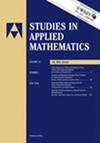Qualitative Analysis for a Fourth-Order Wave Equation With Exponential-Type Nonlinearity
IF 2.3
2区 数学
Q1 MATHEMATICS, APPLIED
引用次数: 0
Abstract
This paper is concerned with the properties of solutions to the following fourth-order wave equation with exponential-type nonlinearity:
where the exponential nonlinearity is classified as either subcritical growth or critical growth at infinity, based on the Adams-type inequality. By utilizing the potential well theory and Adams-type inequality, we first prove the existence, stability, and blow-up of solutions at critical energy . Subsequently, when and is subcritical, we provide a sufficient condition for finite time blow-up with arbitrarily positive initial energy, which permits the -inner product of the initial displacement and the initial velocity to be negative. The upper bounds of the blow-up time are then estimated via the concavity method. Furthermore, when is critical, we also establish a criterion for finite time blow-up with negative initial energy. Finally, in the specific case where and the initial energy can be arbitrarily large, we employ an improved concavity method, in conjunction with the contradiction argument, to derive a weaker sufficient condition for finite time blow-up.
一类四阶指数型非线性波动方程的定性分析
本文研究下列四阶指数型非线性波动方程解的性质:U t t + Δ 2u + U + ωΔ 2 u t + μ u t = f (u)), $$\begin{equation*} {u_{tt}} + {\Delta ^2}u + u + \omega {\Delta ^2}{u_t} + \mu {u_t} = f(u), \end{equation*}$$,其中指数非线性f $f$被分类为亚临界增长或临界增长在无穷远,基于亚当斯型不等式。利用势阱理论和adams型不等式,首先证明了临界能量E (t 0) = d $E(t_0)=d$解的存在性、稳定性和爆破性。随后,当μ >−ω λ 1 $\mu >-\omega \lambda _1$和f $f$是次临界的,我们提供了具有任意正初始能量的有限时间爆炸的充分条件。这使得l2 $L^2$ -初始位移和初始速度的内积为负。然后用凹度法估计爆炸时间的上界。此外,当f $f$为临界时,我们还建立了负初始能量有限时间爆破的判据。最后,在ω = μ = 0 $\omega =\mu =0$和初始能量E (0) >0 $E(0)>0$可以任意大,我们采用改进的凹性方法,结合矛盾论证,推导出有限时间爆破的一个较弱的充分条件。
本文章由计算机程序翻译,如有差异,请以英文原文为准。
求助全文
约1分钟内获得全文
求助全文
来源期刊

Studies in Applied Mathematics
数学-应用数学
CiteScore
4.30
自引率
3.70%
发文量
66
审稿时长
>12 weeks
期刊介绍:
Studies in Applied Mathematics explores the interplay between mathematics and the applied disciplines. It publishes papers that advance the understanding of physical processes, or develop new mathematical techniques applicable to physical and real-world problems. Its main themes include (but are not limited to) nonlinear phenomena, mathematical modeling, integrable systems, asymptotic analysis, inverse problems, numerical analysis, dynamical systems, scientific computing and applications to areas such as fluid mechanics, mathematical biology, and optics.
 求助内容:
求助内容: 应助结果提醒方式:
应助结果提醒方式:


